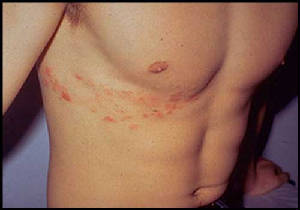Postherpetic Neuralgia
A Case of Persistent Pain after an Attack of Shingles.

Shingles is the reactivation in the adult, of the chicken pox virus that most of us were exposed to in our childhood. It most often takes the form of a linear band of discontinuous ulcerating pustules that resemble a very localized version of chicken pox. Usually a day or more of pain, itching or burning precedes the eruption of the vesicles. The vesicles are noted to develop over days and resolve over days to weeks later.
These lesions are often quite painful. In most people in a few weeks the episode has resolved. Though in a few, the pain in the area of the shingle attack remains even after the lesions has healed. If this persists more than three months, it may be called Postherpetic Neuralgia. This denotes a more persistent and chronic painful state with either burning, sharp or stabbing pain that can be for some very difficult to control.
Besides the usual pain medications; the Tylenol, Motrin, combination narcotics (like Percocet or Vicodin), often we prescribe more long lasting and subtle pain medications. These medications come from two classes: The anticonvulsants (anti-seizure) medications and the tricyclic antidepressants (older antidepressants than the new SSRIs like Prozac). These medications work on changing how the pain is transmitted to and processed in the brain. Their effects becoming apparent over days, weeks or even months of use. These would be taken every day and may not have much of an effect for the first week, though over time, the overall pain level would slowly decrease. Doubling up on the medication during a really painful period is unlikely to make it work any quicker. This would most likely just lead to more side effects.
As my first choice, I usually prescribe a tricyclic antidepressant:
Elavil (Amitriptyline) taking 25mg at night for the first 5 to 7 days, then increasing to 50mg at night for the next 5 to 7 days, and may increase to 75mg at night if tolerated in another week or two. The increase in dose can be slowed down for people who experience more side effects at first. Some typical side effects are dry mouth and sleepiness. I often purposefully use it with people who have difficulty sleeping. Its not necessary to get to a certain dose, rather one should remain at the most effective and well tolerated dose. The doses I use are well below the doses that used in the treatment of depression. Indeed, this medication is effective for the treatment of depression. The problem is that Elavil when dosed at effective levels for depression has more profound side effects than the new class of antidepressants like Prozac and Zoloft. Lastly, It is a good idea to have had an EKG (a simple monitoring study of your heart) recorded sometime in the past prior to starting Elavil. I often can use one that was done at previous visit. In the rare case that you have an electrical conduction problem in your heart, Elavil may cause a serious cardiac arrhythmia. Some people also see some weight gain while on Elavil.
I will also sometimes prescribe Neurotin (Gabapentin) which is an anti-seizure drug. I usually settle on between 600 mg three times a day and 900 mg three times per day. It has side effects as well, with some complaining of sleepiness, slowed thinking and occasionally some weight gain. Most people tolerate it just fine.
Some studies suggest that getting good pain control is helpful in preventing the transformation from a one time self-resolving attack of Shingles to a more prolonged Postherpetic Neuralgia. This may be more applicable to those people over 50 year old and with a particularly severe attack of Shingles, than someone in their 30's with a mild case.
Here is a Good Website Discussing Shingles
http://www.emedicinehealth.com/shingles/article em.htm
Return to Diseases
